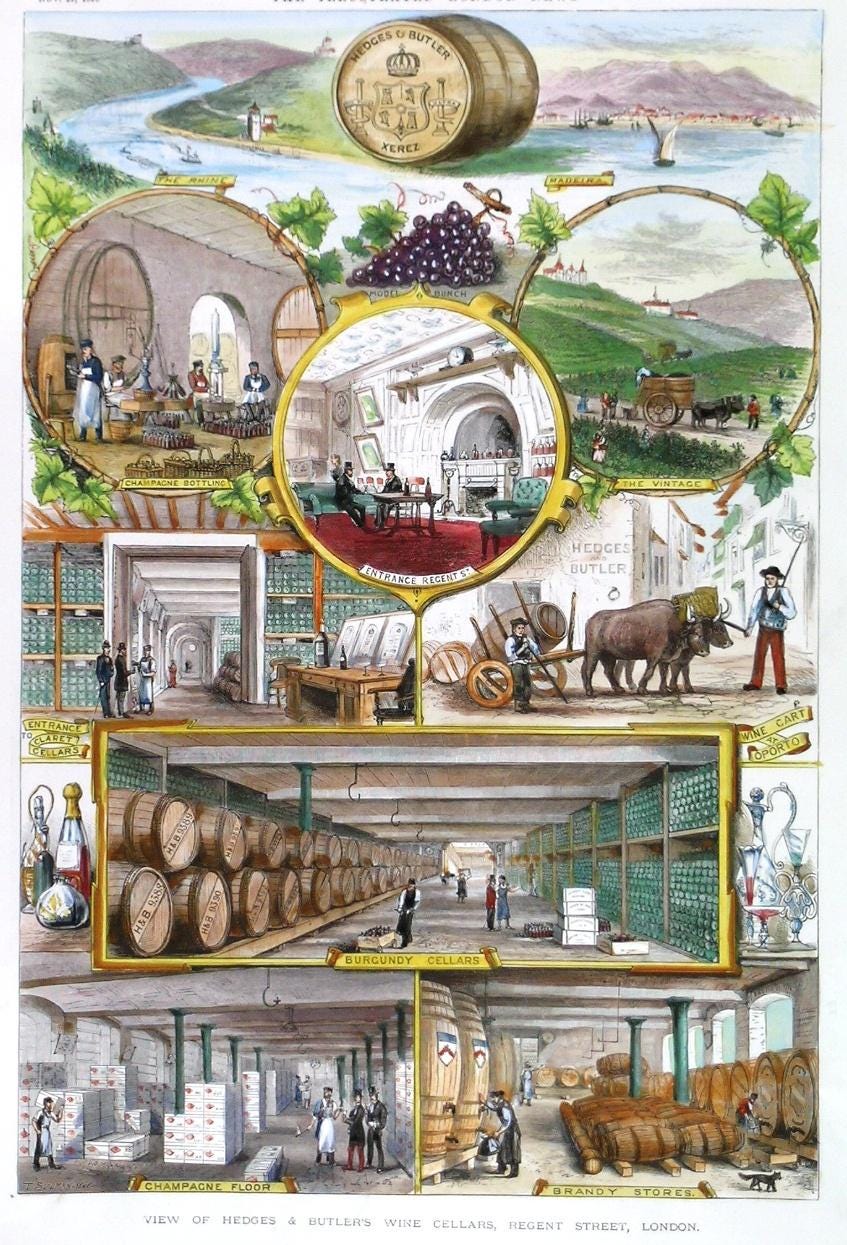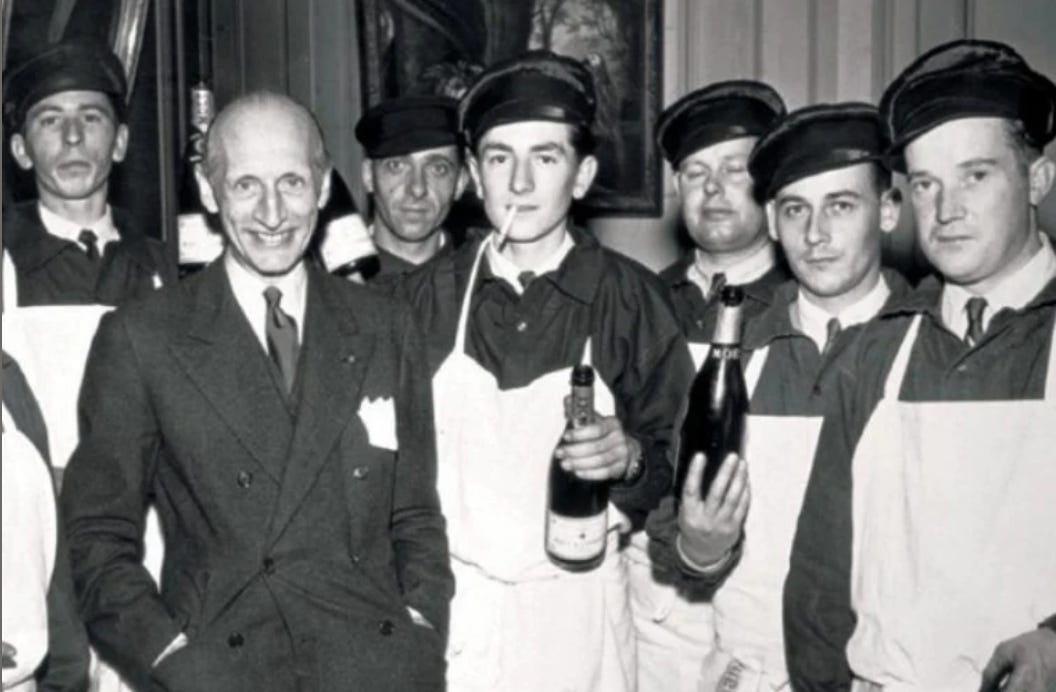The man who invented luxury Champagne
A free-to-read insight into why so many people will spend daft amounts of money on something fizzy to drink over the next two weeks. And the man who's to blame.
1932 is not remembered as one of the great vintages for wine.
In Bordeaux, France it was remembered as the last of the “diabolical years”. A run of horrific vintages producing forgettable wines that were impossible to sell. 1932 was a cold year. And a wet one too. In fact the wettest on record at the time which meant vines were riddled with disease. The wines were “a disaster”. Most Bordeaux chateaux didn’t even bother to bottle their wines.
It was similar elsewhere. On 3rd December in the Illustrated London News there was an item from Messrs Hedges and Butler, wine merchants on Regent Street, “who state that their correspondents in the wine-producing countries of Europe, are not very enthusiastic about the 1932 vintage”. It was a problem that compounded an already difficult situation. The Great Depression had begun in 1927 and parts of the economy were still to recover. It was not a good time to be selling expensive wine.
But some were already preparing for that recovery. I can find no picture of Laurence Venn on the internet. I’m not sure if that’s because there isn’t one, or because his creation is so pervasive. (If you know of one please let me know.) This English journalist and early wine marketing consultant was the man who created the idea of “luxury cuvee” Champagne. An idea was soon turned into the brand Dom Perignon.
A Wedding Present
Dom Perignon was actually a wedding present. That is the brand “Dom Perignon”. Not the late 17th, early 18th century monk after whom it is named. When Francine Durand-Mercier married Paul Marie Bernard Chandon-Moët in 1927, part of her dowry was a little known Champagne brand name, “Dom Perignon”. The Mercier family had released “Dom Perignon” Champagnes before. But unsure what to do with the brand name, they gave it to their new son-in-law. And probably didn’t think that much more about it.
Venn did not work for the Merciers or the Chandon-Moëts. He was a marketing consultant for the Syndicat de Grand Marques de Champagnes, a collective regional body of Champagne producers. Producers who were struggling to sell their wines in the shadow of The Great Depression.
The general view at the time was that they should boost demand by lowering prices. But in 1932 Venn proposed the opposite. Rather than cutting prices, why not increase them? Why not create something that appealed to Champagne’s wealthiest clients, by offering them the ultimate in quality and luxury? It was an idea that did not go down well at first. But the Director of Moët et Chandon, Comte Robert-Jean de Vogüé the husband of Ghislaine d’Eudeville heiress to the Moët fortune, thought it sounded interesting. So did their UK importers, Simon Bros. & Co.
Initially Comte Robert-Jean de Vogüé and Simon Bros. & Co. decided to do a “special bottling” of the 1926 harvest for their most loyal UK customers “specially shipped for Simon Bros. & Co.’s Centenary 1835 - 1935”. At this stage there was no mention of Dom Perignon, although they did use the unusual antique-style bottle you see today. And it was an instant success. So much so that Comte Robert-Jean de Vogüé decided to do the same thing in the USA with the 1921 vintage. But the name of Simon Bros. & Co. was irrelevant in the USA. So de Vogüé thought to use that dowry gift that had been sitting quietly in the family archives - Dom Perignon. One of the first customers was the billionaire James Buchanan Duke who ordered 100 bottles. Like the UK, this “luxury cuvee” Champagne was an instant hit.
“Premium” versus “Luxury”
Ben Gilbert and David Rosenthal host the “Acquired” podcast. In their 2023 episode “The Complete History & Strategy of LVMH” (an outstanding holiday listen) they discuss the difference between “premium” and “luxury”. (LVMH is short for Moët Hennessy Louis Vuitton, the company that today owns Dom Perignon, Moët & Chandon, and Mercier Champagnes. Listen to the podcast to hear why it’s “Moët Hennessy Louis Vuitton” in words but “LVMH” in acronym).
There is no hard and fast definition of what makes a “luxury” product. But Ben and David discuss the general rule that you pay more for a “premium” product because it does a better job than a cheaper one. However “Luxury” products may actually be less useful or practical than their cheaper counterparts. But for the people who buy them they “mean” more. That’s what you’re paying for.
For example, it turns out the overwhelming majority of Rolls Royce owners also drive a Mercedes-Benz. A top-end Mercedes is a “premium” product. It does a better job of “being a car” than a less expensive Mercedes. But a Rolls Royce actually does a less good job of being a car. It’s hugely impractical, it’s a bugger to park, and a nightmare to clean if your children spill Ribena on the back seats. But a Rolls Royce means more. So much more. It means you are the sort of person “who drives a Rolls Royce”. That’s what you pay for. And people who want to be “the sort of person who drives a Rolls Royce” will pay a lot. So you drive your Rolls in order to “be someone”. You drive your Mercedes in order to “do something”.
Dom Perignon tastes nice. In the same way that a Rolls Royce is a pleasant car to drive. But just as you can get a similar driving experience from cheaper cars, you can get similarly delicious Champagnes for a lot less money. (DM me for recommendations). But other Champagnes don’t say “you’re the sort of person who drinks Dom Perignon”. And there are plenty of people who want to be “the sort of person who drinks Dom Perignon”.
The power of stories
Or as Dr Daniel Langer, President & CEO of ÉQUITÉ Luxury and Brand Equity Consultancy puts it:
Premium brands… focus more on functional benefits and tend to appeal to the rational side of consumers
While…
luxury brands are masters of storytelling. They create powerful narratives that make their values tangible, far beyond heritage, craftsmanship, or quality. These stories help consumers connect with the brand on a deeper level and justify the high price points. The stories often evoke a sense of cultural connection or artistic expression.
He explains that great brands invoke…
feelings of belonging, prestige, aspiration, or exclusivity. The story is more important than the product itself, because it drives the value significantly.
In Dom Perignon luxury Champagne has a hell of a story. "Come quickly, I am tasting the stars!" said the original Dom Perignon, the French Benedictine monk credited with inventing sparkling wine. Except he didn’t and didn’t. The quote appears for the first time in a 19th century advertisement. And when Dom Perignon was alive the sort of in-bottle secondary fermentation that produces sparkling wine was a problem, not a benefit. And at that time Champagne mostly made red wine. Dom Perignon was not the first person to use corks either. And he didn’t come up with the idea of blending different wines together. And he wasn’t blind. When they say he was “blind tasting” it means he didn’t know what the wines were he was tasting.

But why let the facts get in the way of great stories? All those stories are told, and believed by people who buy (into) Dom Perignon. Many luxury brands take a truth and stretch it almost beyond recognition. Yes, Rolex made a Deepsea watch that accompanied James Cameron to the bottom of the Mariana Trench. No, it couldn’t survive at the bottom of the Mariana Trench. Yes, Coco Chanel had a relationship with a Nazi officer. No, she wasn’t a paid up Nazi. Yes, Jane Birkin did meet the CEO of Hermés on a flight. But the story you’ll usually hear today is somewhat embellished.
What gives Dom Perignon its value - what gives all luxury brands their value - are the “feelings of belonging, prestige, aspiration, or exclusivity. The story is more important than the product itself.” Whether those feelings are rooted in truth is by the by.
If you pop open a bottle of luxury or “prestige “ Champagne this Christmas or New Year I hope you enjoy “feelings of belonging, prestige, aspiration, or exclusivity”. And toast Laurence Venn, the man who came up with the idea in the first place.







Love it! Cheers and Merry Christmas to you and yours!
Hi Joe,
Did you know that Olivier Krug spent 2 weeks at Stonyhurst in LG, 1983 French exchange with the Jesuit school in Reims.